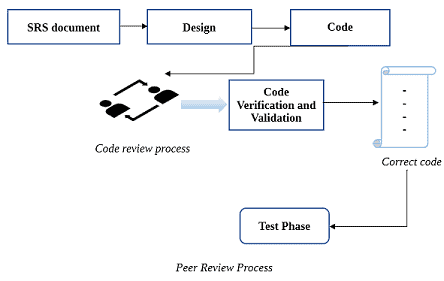Peer review While in its provisional stage, the peer review process will begin as early as possible. It can be viewed as a move towards a more positive creation of apps. Developers can decide on the time for peer testing, which could be a weekly or quarterly analysis of their codes. A peer review has both’ formal’ and’ informal’ ways to deliver the final outcome, which could result from developer consensus. Okay, the principle of peer review provides a common ground among developers working on a project to consider a specific issue or the reality that what contributed to such a question and so on. The peer-review process has acquired sufficient space in software development over the years. There are actually two types in a peer-review process: Paired Code Reviews Community Peer Review Process: Informal-This is not a very organized method of review. This can be achieved with a fellow developer on a cup of coffee. Walk-through- In this method, a software developer leads a team of programmers and other stakeholders interested in the software product to review the product and ask questions about the software product, if any. Discussion-This is a more formal way to discuss a co-worker’s duties. Inspection-This is a systematic way to conduct the evaluation process. This requires using different metrics to measure the outcomes of the review process and determine how beneficial or true the conclusion is. Peer Review Features: It is a standardized form of appraisal that incorporates a mechanism of identification of faults including peers and few technical experts.
There is no management team involved in this strategy. Typically a leader follows. All the things that need consideration are included in the paper.
Peer Review Benefits: Improvement in Work Product Performance-Well, performance is certainly discussed through this analysis, because when you look at your fellow participants ‘ Work Product, it’s a normal strategy to try to find flaws. So, a coder focuses on this mission with a great deal of passion to find the gaps in the application. As a consequence, the cycle continues with an inquisitive attitude allowing for the likelihood of reducing the number of defects. Steady progress in the research- A goal is established before the peer review process starts. So, when the process actually began, team members are planning to accomplish the final goal. A sense of belonging within the community- The peer review method certainly instills a sense of team spirit, as the task is to find bugs and impose the same impact on the other person. It’s a sort of competition that ultimately leads to a team effort-winning over another. Improved workplace coordination — Groups working together regularly share thoughts, taking their fellow team leaders ‘ opinions on similar issues. It allows the development of awareness that, seamlessly, will effectively meet the challenges.
Improved learning strength is cohesion
When people recognize the importance or significance of team spirit, this maxim remains so valid. So, as team members share ideas and opinions within the team or with another team, it helps to slowly develop a lot of information about a subject. Cost-effective —Imbibing peer review as part of the life cycle of software development tends to curtail the cost of exporting the program being created to check any external resource, purchase or update device licenses, and so on.
Conclusion:
Peer review is an effective technique for a collaborative problem-solving approach. It helps to gain a better insight into a topic when one is delving into another’s a task. This makes the person understand various ways to perform a function that he may never have actually done or dreamed about himself. In the long run, peer review is and will act as a way of achieving a high-quality work product.
